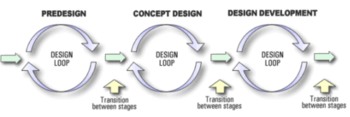Integrated Design Process (IDP)
| Line 1: | Line 1: | ||
| − | The Integrated Design Process (IDP) is a high performance, holistic, method that mostly appear in conjunction with a construction project | + | The Integrated Design Process (IDP) is a high performance, holistic, method that mostly appear in conjunction with a construction project. It commonly refers to a process where the design of the construction is done in close collaboration, and with consideration for, the other disciplines. It is a process where the different design teams/disciplines (for example: Architect, Structural engineers, Building Services engineers, etc.) work closely to make sure the all of the aspects of the design is adapted to make the design as good as possible. For this reason, the term “Whole building” is often seen in the context of IDP. All of the subjects focus on making the construction with each other and the user in mind.<ref>[https://www.tpsgc-pwgsc.gc.ca/biens-property/sngp-npms/bi-rp/conn-know/enviro/pci-idp-eng.html#a3] ''Public Service and Procurement Canada (2018). Integrated Design Process.'' </ref><ref>[http://proquestcombo.safaribooksonline.com.proxy.findit.dtu.dk/book/software-engineering-and-development/project-management/9781933890524/firstchapter#X2ludGVybmFsX1BGVmlldz94bWxpZD05NzgxOTMzODkwNTI0JTJGNzEmX19pbWFnZXBhZ2VyZXNvbHV0aW9uPTgwMCZxdWVyeT1pbnRlZ3JhdGVkJTIwZGVzaWdu] ''Project Management Institute, (2008).The Standard for Management - Second Edition. Publisher: Project Management Institute. Page 71'' </ref> |
| − | Compared to the traditional design process, where one team wins the offer and then outsource the other technical tasks to different | + | Compared to the traditional design process, where one team wins the offer and then outsource the other technical tasks to different teams after a design is made, the teams interact on the same authority level. They discuss issues and opportunities to best meet the client’s requirements. The goal is to be more efficient and ensure that the quality is not jeopardized in one or more decisions, and that the different designs is integrated for its overall purpose.<ref>[https://books.google.co.uk/books?id=RzuEiv4Rvu4C&printsec=frontcover&source=gbs_ge_summary_r&cad=0] ''Moe, Kiel, (2008). Integrated Design in Contemporary Architecture. Publisher: Princeton Architectural Press.'' </ref> |
IDP done successfully identifies slippage and problems before the production phase and saves the project cost, enhances quality, optimizes operations in production and after and facilitates for development of sustainability in contraction. | IDP done successfully identifies slippage and problems before the production phase and saves the project cost, enhances quality, optimizes operations in production and after and facilitates for development of sustainability in contraction. | ||
| Line 8: | Line 8: | ||
| + | == Theory behind == | ||
| − | + | The Integrated Design Process could be seen as an offspring or underlying category of the Integrated Process or Integrated Management. It is based on the same theory to enhance the collaboration and coordination of a program or project. In a program/project management view ''“Integration requires making choices as to where to concentrate resources and effort, anticipating issues and dealing with them before they become critical, and coordination work for the overall success (…)”''.(2) To fulfil these actions, the stakeholders must have clear requirements and the project/program team must have a common goal, not individual targets. The success of the project must be priority in every decision, this means that trade-offs and sacrifices must be made for the projects best. Every discipline must concede to work for the project’s success, not the glory of the discipline. This will give the needed basis to complete an integrated design process. | |
Revision as of 16:55, 16 February 2018
The Integrated Design Process (IDP) is a high performance, holistic, method that mostly appear in conjunction with a construction project. It commonly refers to a process where the design of the construction is done in close collaboration, and with consideration for, the other disciplines. It is a process where the different design teams/disciplines (for example: Architect, Structural engineers, Building Services engineers, etc.) work closely to make sure the all of the aspects of the design is adapted to make the design as good as possible. For this reason, the term “Whole building” is often seen in the context of IDP. All of the subjects focus on making the construction with each other and the user in mind.[1][2]
Compared to the traditional design process, where one team wins the offer and then outsource the other technical tasks to different teams after a design is made, the teams interact on the same authority level. They discuss issues and opportunities to best meet the client’s requirements. The goal is to be more efficient and ensure that the quality is not jeopardized in one or more decisions, and that the different designs is integrated for its overall purpose.[3]
IDP done successfully identifies slippage and problems before the production phase and saves the project cost, enhances quality, optimizes operations in production and after and facilitates for development of sustainability in contraction.

Theory behind
The Integrated Design Process could be seen as an offspring or underlying category of the Integrated Process or Integrated Management. It is based on the same theory to enhance the collaboration and coordination of a program or project. In a program/project management view “Integration requires making choices as to where to concentrate resources and effort, anticipating issues and dealing with them before they become critical, and coordination work for the overall success (…)”.(2) To fulfil these actions, the stakeholders must have clear requirements and the project/program team must have a common goal, not individual targets. The success of the project must be priority in every decision, this means that trade-offs and sacrifices must be made for the projects best. Every discipline must concede to work for the project’s success, not the glory of the discipline. This will give the needed basis to complete an integrated design process.
- ↑ [1] Public Service and Procurement Canada (2018). Integrated Design Process.
- ↑ [2] Project Management Institute, (2008).The Standard for Management - Second Edition. Publisher: Project Management Institute. Page 71
- ↑ [3] Moe, Kiel, (2008). Integrated Design in Contemporary Architecture. Publisher: Princeton Architectural Press.
- ↑ Lean Enterprise Institute,http://task23.iea-shc.org/integrated-design-process, accessed: 08.02.18